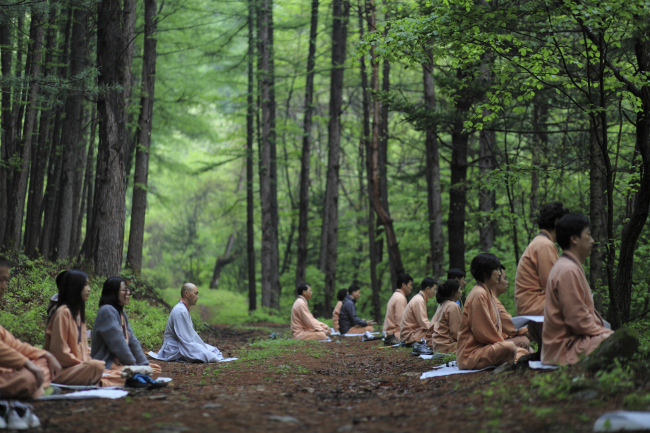Korean Buddhist cultural offerings designed to go global
Buddhism is not just a religion in Korea. It is an integral cultural asset that has substantially contributed to the development of the country’s tradition and arts for the last 1,700 years.
The Korean Buddhist culture now attempts to go abroad in an effort to better serve the rising global demand for learning about Korean history and culture, thanks to the popularity of K-pop around the world.
The Cultural Corps of Korean Buddhism, an affiliate of the Jogye Order of Korean Buddhism, plans to develop various programs to promote its two signature cultural offerings ― Templestays and temple food.
Its latest development includes a Templestay program designed exclusively for K-pop fans from France created in collaboration with the Korea Tourism Organization. It also plans to open the first temple food restaurant on the rooftop of the French department store Galeries Lafayette in Paris next year.
Buddhism is not just a religion in Korea. It is an integral cultural asset that has substantially contributed to the development of the country’s tradition and arts for the last 1,700 years.
The Korean Buddhist culture now attempts to go abroad in an effort to better serve the rising global demand for learning about Korean history and culture, thanks to the popularity of K-pop around the world.
The Cultural Corps of Korean Buddhism, an affiliate of the Jogye Order of Korean Buddhism, plans to develop various programs to promote its two signature cultural offerings ― Templestays and temple food.
Its latest development includes a Templestay program designed exclusively for K-pop fans from France created in collaboration with the Korea Tourism Organization. It also plans to open the first temple food restaurant on the rooftop of the French department store Galeries Lafayette in Paris next year.

Templestay was one of the cultural projects introduced during the Korea/Japan World Cup in 2002 as part of the government’s effort to offer the world a better understanding on the country’s traditional culture. The program as well as general Buddhist cultural practices remained nearly unknown even to many Koreans until then. In the last decade, however, the programs have been gaining popularity both at home and abroad for their unique roles in delivering Korean culture as well as offering a rare chance to contemplate the meaning of life and heal the tired mind while surrounded by nature.
Templestay is a cultural program that allows people to stay in mountainside temples and participate in Zen meditation, early-morning chanting and daily chores.
“Through the Templestay, participants can learn the wisdom of monastic life and the philosophy of a peaceful co-existence with nature. The program is not only designed to offer cultural understanding but also to offer new direction for people struggling in the highly competitive society,” said Ven. Deung Mok, deputy director of the Cultural Corps of Korean Buddhism.
“Templestay will be developed into various programs and will continue to serve people’s needs not only in Korea but also people coming from all over the world,” he added.
The number of temples offering Templestay programs across the country has surged from 33 in 2002 to 118 last year. About 1.9 million people have participated in the program as of late last year. In 2011 alone about 190,000 people, including 25,000 foreign travelers, joined the program, officials at the group said.
The unique program has also contributed to enhancing Korea’s image abroad.
Templestay was selected as one of the most successful tourism items by the Organization for Economic Cooperation and Development in 2009.
An OECD report titled “The Impact of Culture on Tourism” included Korea’s Templestay program as a successful combination of culture and tourism, along with other strategic tourism sites such as the Vorarlberg Province in Austria, the State of Michoacan in Mexico and the Industrial Monuments Route of the Silesian Voivodeship in Poland.
With the success of the project, Culture Ministry transferred the project from the Religious Affairs Office to Tourism Industry Bureau last year.
“The government has decided to transfer the project to the tourism bureau because it is no longer about religious affairs but an important tourism resource for Korea,” said Hong Seung-mo, an official at the department of tourism promotion.
The government spends 20 billion won ($17.72 million) a year for developing various Korean Buddhist cultural content, from Templestay to temple food. The budget also includes expenditure on renovation at temples to help them better accommodate participants coming from all around the world.
Temple food has been also drawing attention from abroad, particularly among the health-conscious in North America and Europe.
To better promote the 1,700-year-old culinary assets, the Cultural Corps of Korean Buddhism is seeking ways of modernizing the recipes while preserving the traditional style of temple food. It also plans to provide recipes for nutritious vegetarian food and to hold a campaign against food wastage.
The religious group has been holding seminars on temple food in the U.S. and also participated in ITV, an international tourism exhibition in Germany, earlier this year.
By Cho Chung-un (christory@heraldcorp.com)
-
Articles by Korea Herald


![[AtoZ into Korean mind] Humor in Korea: Navigating the line between what's funny and not](http://res.heraldm.com/phpwas/restmb_idxmake.php?idx=644&simg=/content/image/2024/04/22/20240422050642_0.jpg&u=)

![[Exclusive] Korean military set to ban iPhones over 'security' concerns](http://res.heraldm.com/phpwas/restmb_idxmake.php?idx=644&simg=/content/image/2024/04/23/20240423050599_0.jpg&u=20240423183955)

![[Herald Interview] Why Toss invited hackers to penetrate its system](http://res.heraldm.com/phpwas/restmb_idxmake.php?idx=644&simg=/content/image/2024/04/22/20240422050569_0.jpg&u=20240422150649)
![[Graphic News] 77% of young Koreans still financially dependent](http://res.heraldm.com/phpwas/restmb_idxmake.php?idx=644&simg=/content/image/2024/04/22/20240422050762_0.gif&u=)







![[Exclusive] Korean military to ban iPhones over security issues](http://res.heraldm.com/phpwas/restmb_idxmake.php?idx=652&simg=/content/image/2024/04/23/20240423050599_0.jpg&u=20240423183955)



![[Today’s K-pop] Ateez confirms US tour details](http://res.heraldm.com/phpwas/restmb_idxmake.php?idx=642&simg=/content/image/2024/04/23/20240423050700_0.jpg&u=)